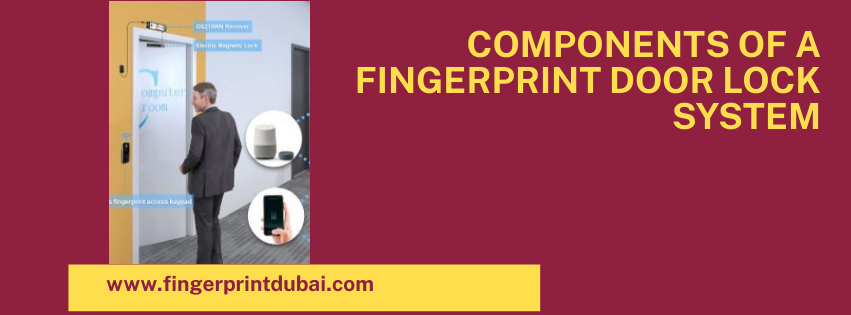Components of fingerprint door lock system
What are the components of fingerprint door lock system?
A fingerprint door lock system is a sophisticated security measure that grants access based on a unique biometric identifier: your fingerprint is key to your ABM digital Lock
Here’s a breakdown of the key components that make this magic happen:
- Fingerprint Sensor: This is where the action begins. The sensor captures an image of your fingerprint.2 Different types exist, like optical, capacitive, and ultrasonic, each with its own strengths and weaknesses.3
- Fingerprint Processor: This component analyzes the captured image. It extracts unique features like minutiae prints on finger (ridge the points endings and bifurcations). Think of it as the digital lock’s brain – it’s responsible for recognizing the intricate pattern of your fingerprint.
- Microcontroller: The microcontroller acts as the central control unit. 4 It receives the processed fingerprint data from the processor.5 It compares this data with the stored templates of authorized users. If a match is found, the microcontroller signals the lock to unlock.
- Door Lock Mechanism: This is the physical part of the system that secures your door. It could be a traditional deadbolt, an electronic latch, or even a motorized strike plate. The microcontroller controls the lock mechanism to either open or remain locked.6
- Power Source: Fingerprint door locks can be powered by various sources: Batteries: Convenient for easy installation but require regular replacement. AC Power: Provides continuous power but limits portability. Solar Power: Environmentally friendly and suitable for outdoor use.
- User Management System (Optional): More advanced systems might include software for managing user access. This allows you to easily add or delete users, set access permissions, and monitor access logs.
The components of a fingerprint door lock system are essential for creating a secure and convenient access control solution. Let’s dive into the key elements that make up this innovative security technology.
5 Essential Components of a Fingerprint Door Lock System
- Fingerprint Sensor
The fingerprint sensor is the heart of any fingerprint door lock system. This sophisticated device captures and digitizes the unique patterns of a user’s fingerprint.
When you place your finger on the sensor, it scans the ridges and valleys of your fingerprint, converting this biometric data into a numerical template. Modern fingerprint sensors use advanced algorithms to ensure accurate and reliable readings, making them highly secure and difficult to fool.
- Microcontroller (e.g., ABM)
The ABM microcontroller acts as the brain of the fingerprint smart digital door lock system. It processes the data from the fingerprint sensor and controls the other components. Many systems use Arduino boards, such as the Arduino Uno, due to their versatility and ease of programming. The microcontroller compares the scanned fingerprint data with pre-stored templates to authenticate users and decide whether to grant access.
- Locking Mechanism
The locking mechanism is what physically secures or releases the door. Most fingerprint door lock systems use a solenoid lock or an electromagnetic lock. When a valid fingerprint is detected, the microcontroller sends a signal to activate the locking mechanism, allowing the door to open. This component ensures that the biometric authentication translates into real-world security.
- Power Supply
A reliable power supply is crucial for any fingerprint door lock system. Many systems use batteries, often alkaline batteries, to provide the necessary power. Some advanced systems may include backup power options or low-battery alerts to ensure continuous operation. The power supply energizes all the other components, from the fingerprint sensor to the locking mechanism.
- User Interface
The user interface allows for interaction with the fingerprint door lock system. This often includes an LCD display that provides feedback and status information. Some systems incorporate LED indicators to show successful or failed authentication attempts. Advanced biometric door locks may also feature additional interface options like keypads or mobile app connectivity for added flexibility.
Additional Components for Enhanced Functionality
Relay Module
A relay module acts as an electronic switch in the fingerprint door lock system. It helps control the flow of electricity to the locking mechanism based on signals from the microcontroller. The relay ensures that the low-power signals from the microcontroller can effectively control the higher-power locking mechanism.
Wi-Fi or Bluetooth Module
Some advanced fingerprint door lock systems include wireless connectivity options. These modules allow for remote management and monitoring of the lock. Users can potentially control access, receive notifications, or check lock status through a smartphone app.
Buzzer
A buzzer provides audible feedback in a fingerprint door lock system. It can alert users to successful unlocking, failed attempts, or low battery conditions. This component enhances the user experience and adds an extra layer of security awareness.

FAQs about Fingerprint Door Lock Systems
Q: How secure are fingerprint door locks?
A: Modern fingerprint door locks employ advanced algorithms and encryption techniques to enhance security. However, commonly like any biometric security system, they are not claim entirely foolproof. Factors like sensor quality, fingerprint image clarity, and the number of stored templates can impact security.
Q: Can fingerprints be easily duplicated?
A: High-quality fingerprint sensors and sophisticated algorithms make it extremely difficult to duplicate fingerprints for unauthorized access. Advanced systems often use multiple points of verification to further enhance security.
Q: Are fingerprint door locks easy to install?
A: Many fingerprint door locks are designed for easy Do It Yourself installation. However we suggest, if you’re not technical hand and unsure do it perfectly, it’s always advised best to consult with a professional door lock installer.
Q: What are the benefits of using ABM fingerprint digital door lock?
A: Convenience: No need to fumble for keys. Enhanced Security: Reduces the risk of lost or stolen keys.7 Increased Control: Granular control over who has access to your property. Improved Safety: Can deter intruders and provide peace of mind.8
In conclusion,
The components of a fingerprint door lock system work together to create a seamless, secure, and convenient access control solution. From the high-tech fingerprint sensor to the robust locking mechanism, each part plays a crucial role in ensuring that only authorized individuals can gain entry. As biometric technology continues to advance, we can expect these systems to become even more sophisticated, offering enhanced security and user-friendly features for homes and businesses alike. By understanding the components of a fingerprint door lock system, you can make an informed decision about whether this technology is the right choice for your home or business.
4th St, Al Quoz Cemetery, Oasis Mall, Waha Street, Dubai UAE
Email : info@fingerprintdubai.com
Tell : (+971) 052 5571309

